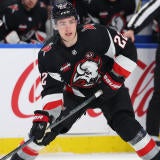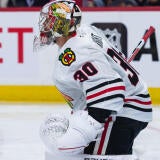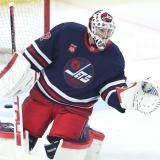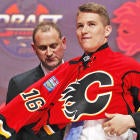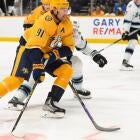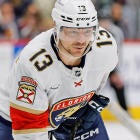Prospects analysis: NHL Draft first-round review
With the 2016 NHL Entry Draft in the books, here's a look at how the first-round picks shook out and how they're expected to impact their new teams.
1. Toronto Maple Leafs: Auston Matthews (C, Zurich-Switzerland): As soon as the Leafs made it clear that they weren't interesting in trading this selection, there was a zero percent chance that this pick would be anyone other than Matthews. I've said before that I don't think Matthews is of the caliber of either Connor McDavid or Jack Eichel, but he is a darn good prospect and in my opinion easily the top player available. Matthews' decision to spend this past season in Switzerland was a smart one. The Swiss league is perennially underrated, and his game wouldn't have improved if he was playing collegiate or junior hockey against overmatched competition. Matthews is ready to play in the NHL from both a physical and skill point of view, and I expect him to serve as Toronto's second-line center next season. The Leafs could very easily be a lousy hockey team again next year (mostly due to the defense), but I don't think they're going to have any problems scoring goals. They have established and talented veterans such as Nazem Kadri, Tyler Bozak and James van Riemsdyk, while top prospects Mitch Marner and William Nylander figure to spend the majority of the year in the NHL. The Matthews-Marner-Nylander trio should terrorize the league for the next decade-plus. Individually, they are three of the top 10 or so prospects in the entire league. I could see Matthews' numbers in his rookie season being similar to what Eichel did this past year (24 goals, 56 points). Eichel has more natural offensive ability, but Matthews figures to have a better supporting cast around him. Long term, he has all the tools to be a first-line center who can impact the game in a multitude of areas.
2. Winnipeg Jets: Patrik Laine (RW, Tappara-Finland): As expected, all the rumors that came out Thursday night about the Jets being interested in someone other than Laine were simply an attempt to drum up trade interest in the pick. Laine is a prototypical sniper. He has a terrific shot, one of the best I've seen in my decade-plus covering NHL prospects, and he's ready to play in the NHL right now. Laine has a real chance to be a perennial 35-to-40-goal scorer for the Jets. Obviously, Fantasy owners shouldn't expect that right away, but he figures to produce enough next season to be worthy of a roster spot in most leagues.
3. Columbus Blue Jackets: Pierre-Luc Dubois (LW, Cape Breton-QMJHL): I had Dubois ranked eighth amongst this year's available prospects, so it's safe to say that I don't like this selection. The Jackets have said they view Dubois as a center, and by all accounts they expect him to play in the NHL this season. He's a physically mature kid, so I wouldn't rule out his ability to help Columbus out immediately, but I think he's better suited to the wing, where his physical style of play would be more effective. Dubois works his tail off and has posted big goal totals in the QMJHL, but I thought there were safer, higher-upside players available on the board.
4. Edmonton Oilers: Jesse Puljujarvi (RW, Karpat-Finland): As others have said, even when the Oilers don't win the draft lottery, the draft still manages to work out for them. The Oilers need defensemen, as we all know, but they couldn't pass up Puljujarvi. For all of the high picks they've spent on forwards (Connor McDavid, Taylor Hall, Ryan Nugent-Hopkins, Leon Draisaitl), Puljujarvi plays a different style of game. His game is predicated on hard work and tenacity, not raw skill. One of those aforementioned forwards (or perhaps Jordan Eberle) will likely going be moved in exchange for a defenseman at some point this offseason. I'm not as high on Puljujarvi as some others, simply because I'm not convinced he will produce enough offensively to be a first-line forward, but the Oilers lucked out by getting him at this pick.
5. Vancouver Canucks: Olli Juolevi (D, London-OHL): I've always felt you need to swing for the fences with a top-five pick, and while I like Juolevi's chances to be a top-four NHL defenseman, he doesn't have that dynamic element that I would look for with such a high selection. That said, Juolevi is remarkably calm with the puck on his stick, he has great vision and he rarely gets caught out of position defensively, although he needs to add some weight to his frame. I actually think he could play in the NHL this upcoming season if necessary, but I doubt the Canucks will ask him to do so. He's a quality prospect, but I think others have more upside.
6. Calgary Flames: Matthew Tkachuk (LW, London-OHL): A pair of curveballs in the top five resulted in Tkachuk falling into Calgary's lap, and the Flames quickly (and smartly) pounced immediately. Outside of Matthews and Laine, no other player in this draft can impact a game in more ways than Tkachuk. He has terrific hands (particularly from in close), he uses his big body to his advantage, and he can be a pest on the ice. I imagine the Flames will give him every opportunity to make the team next year, although I would send him back to London for one more year. He should be the perfect complement to an undersized player like Johnny Gaudreau.
7. Arizona Coyotes: Clayton Keller (C, U.S. National Team Development Program): To put it in simple terms, Keller has the highest offensive ceiling of any player available in the draft. He has the most points (189) in U.S. NTDP history, and his lack of size (5-foot-10, 170) was the only thing that kept him from being a top-five pick. Keller is committed to Boston University for next season and figures to play at least two years for the Terriers before turning pro. This was a smart, calculated selection by 27-year-old general manager John Chayka.
8. Buffalo Sabres: Alexander Nylander (LW, Mississauga-OHL): Nylander is similar to current Buffalo forward Sam Reinhart in the sense that the majority of his production is the result of his tremendously high hockey IQ. He's well rounded and defensively responsible for an 18-year-old, which comes as no surprise given that his father played 920 NHL games. Nylander was technically loaned to Mississauga from his native Sweden this past season, so he will be eligible to play in the AHL in 2016-17. Long term, he has the look of a productive second-line winger.
9. Montreal Canadiens: Mikhail Sergachev (D, Windsor-OHL): Not only did P.K. Subban not get traded as expected, Habs GM Marc Bergevin added to his defensive core, spending his top pick on the player I had ranked as the top available defenseman. Sergachev has the best chance of all the available defenders to turn into a 30-minute-per-night force at both ends of the rink. He's big and strong, and I imagine he'll be ready for NHL duty after just one more season of junior hockey.
10. Colorado Avalanche: Tyson Jost (C, Penticton-BCHL): Jost's incredible numbers for Penticton this past season (42 goals, 104 points in 48 games) were closely scrutinized because he faced poor competition all year long, but he was undoubtedly one of the most offensively gifted players available in the draft. He was a dominant force for Team Canada at the World U18 Championship and is the rare 18-year-old who will be expected to produce immediately in his freshman college season - he'll start at the University of North Dakota in the fall.
11. Ottawa Senators: Logan Brown (C, Windsor-OHL): The Sens thought highly enough of Brown that they sent an additional pick to the Devils just to ensure they could move up one spot to take him. At 6-6, 210, Brown has the frame and puck skills to be a dominant center at the NHL level, but he's still not strong enough and has no idea how to use his size to his advantage at this point. He's a high-risk, high-reward, long-term project.
12. New Jersey Devils: Michael McLeod (C, Mississauga-OHL): The Devils need an influx of talent at all positions other than goaltender, so their selection of McLeod makes sense even if he didn't produce as much as many expected this past season. A strong skater with good size and a great handle, McLeod has a complete offensive game. The dreadful Devils need him to make an impact sooner rather than later.
13. Carolina Hurricanes: Jake Bean (D, Calgary-WHL): The Hurricanes can't score goals and they have more talented young defensemen than they know what to do with, so what direction did they go in the draft? Another defender. In general manager Ron Francis' defense, Bean may very well have been the best player left on the board. A smooth-skating, left-handed shooting defender who does his best work with the man advantage, Bean is a fine selection at this point in the draft; he just happened to go to a team that appears to have greater needs elsewhere.
14. Boston Bruins: Charlie McAvoy (D, Boston University-NCAA): With McAvoy playing this past season at Boston University, the Bruins presumably got plenty of looks at him and liked what they saw. McAvoy plays a high-risk style, although he cut down on the defensive miscues and boneheaded plays in the second half of the year. McAvoy isn't very tall, but he's thick, he skates well, and he's your classic offensive-minded defenseman. He also might be ready to turn pro after just one more season for the Terriers.
15. Minnesota Wild: Luke Kunin (C, University of Wisconsin-NCAA): I don't like this pick at all. Kunin was productive this past season on a bad Wisconsin team, but I'm not convinced he has the skill to be anything more than a quality third-line center. I would much rather have taken a potential impact defenseman like Jakob Chychrun or a talented goal scorer like Kieffer Bellows. This seems like a missed opportunity for a Wild team that's struggling to get on track in numerous areas.
16. Arizona Coyotes: Jakob Chychrun (D, Sarnia-OHL): Arizona took on Pavel Datsyuk's entire remaining contract in order to move up to this spot for Chychrun. The Coyotes have been adamant in addressing their defense moving forward, even with the addition of Alex Goligoski this week. Chychrun had an inconsistent, frustrating draft season to say the least, but he has good size and is an elite skater -a year ago at this time, he was considered a consensus top-five pick. There are clear risks involved, but this is the kind of selection that bad teams like the Coyotes need to make.
17. Nashville Predators: Dante Fabbro (D, Penticton-BCHL): The Preds see a young defenseman on the board and they just can't help themselves. I'm not entirely convinced that Fabbro will become anything more than an average NHL defenseman, as he has no single elite skill, but Nashville clearly disagrees. Fabbro had a huge scoring year for Penticton, but how he performs next season at Boston University should give us a better idea of how much offensive ability he truly has. I don't see it at this point, but plenty of other knowledgeable people feel differently.
18. Winnipeg Jets: Logan Stanley (D, Windsor-OHL): After taking a monstrous forward in Laine, the Jets nabbed a monstrous defenseman in Stanley, who had a terrific season for Windsor, improving in every aspect of the game. He's a mean, hard-nosed defender who moves pretty well for being 6-6 and can chip in the odd point here and there. Stanley could be a huge asset for the Jets if they deploy him correctly.
19. New York Islanders: Kieffer Bellows (LW, U.S. NTDP): Gifted goal scorers are difficult to find, and Bellows was one of the best available in the draft. Blessed with a terrific shot and deft scoring touch around the net, Bellows potted 50 goals in 62 games for the U.S. NTDP this past season. Off to Boston University in the fall, Bellows' biggest challenge will be improving the other aspects of his game. He doesn't do much when he isn't scoring goals.
20. Detroit Red Wings: Dennis Cholowski (D, Chilliwack-BCHL): The Wings have done well in the draft for more than two decades, so they must be confident that they'll get Cholowski to cut down on the crazy number of high-risk plays he makes on a regular basis. He's a very good skater and moves the puck well, so Detroit could have a nice player on their hands if Cholowski indeed cleans up his game a bit. He's looking at least two or three seasons at St. Cloud State.
21. Carolina Hurricanes: Julien Gauthier (RW, Val-d'Or-QMJHL): As I mentioned before, Carolina can't score goals, so it makes sense here to take a pure goal scorer, even if that means he does little else well. Gauthier had 41 goals this past season in the QMJHL, but there are major questions surrounding both his defensive play and hockey sense. A team as offensively starved as the Hurricanes needed to take a risk like this.
22. Philadelphia Flyers: German Rubtsov (C, Russia U18-MHL): As long as the Flyers can convince Rubtsov to come to North America in some reasonable amount of time, this is a good pick. The Russian is ultimately likely a good third-line center, but there is an outside chance that he could develop into a top-six forward. He has a well-rounded game and works hard, which can't always be said of the young Russians who come over.
23. Florida Panthers: Henrik Borgstrom (C, HIFK JR-Finland): I like Borgstrom a lot -- way more than most -- but this is a reach even for me. He's a very talented offensive player who spent his draft year beating up on overmatched kids in the Finnish junior league. A tall, lanky kid who needs to put on considerable weight, Borgstrom is a going to play at the University of Denver next season, which should help his development.
24. Anaheim Ducks: Max Jones (LW, London-OHL): Jones may never be anything more than a physical role player, but his willingness to take the body and his consistent effort level make him worth the risk at this point in the draft. He got limited ice time on a London team that won the Memorial Cup Championship, but there were clearly times he didn't appear to have the skill or finishing ability to keep up with his more talented teammates.
25. Dallas Stars: Riley Tufte (LW, Fargo-USHL): A freak athlete who has no idea how good he can truly be, it didn't help that Tufte spent half this season playing high school hockey in Minnesota. He has every single tool required to be a dominant power forward, but needs to add weight to his frame and refine his game this coming season at the University of Minnesota-Duluth.
26. St. Louis Blues: Tage Thompson (C, University of Connecticut-NCAA): Thompson is huge and had a very nice freshman season at UConn, but there are concerns. He has been criticized for his lackadaisical style of play, and while I doubt that he's doing it intentionally, I'm not convinced that's the type of thing that can be rectified. I would have looked elsewhere at this point, but I acknowledge that Thompson could be a beast if he can perform on a more consistent basis.
27. Tampa Bay Lightning: Brett Howden (C, Moose Jaw-WHL): Lightning GM Steve Yzerman said he sees Howden as an impact player at both ends of the rink, but I tend to disagree. Howden will show flashes of being an above-average offensive player, but I didn't see enough of it on a regular basis. I would wager on Howden turning into more of a third-line guy than a top-six center.
28. Washington Capitals: Lucas Johansen (D, Kelowna-WHL): This was a quality selection. Coming from a Kelowna program that has produced a countless number of impact defensemen at the NHL level, Johansen's skating ability alone makes him a worthwhile pick at this point of the draft. When you add in his above-average size and his calm demeanor with the puck, Johansen is a potential steal this late in Round 1.
29. Boston Bruins: Trent Frederic (C, U.S. NTDP): I had Frederic ranked 60th in my final draft rankings, so suffice to say that I think the Bruins blew this one. Frederic showed no real offensive ability for the U.S. NTDP, so I don't know why the Bruins are expecting anything more when he goes to the University of Wisconsin in the fall. I think a best-case result for Frederic would be to carve out a career as a physical role player.
30. Anaheim Ducks: Sam Steel (C, Regina-WHL): Steel was a highly decorated bantam player who has consistently underperformed for Regina. He's a good playmaker and an above-average skater, but his development has seemingly stalled. If I was going to spend a pick on a highly touted, chronic underachiever, I would have gone for defenseman Sean Day before Steel.



